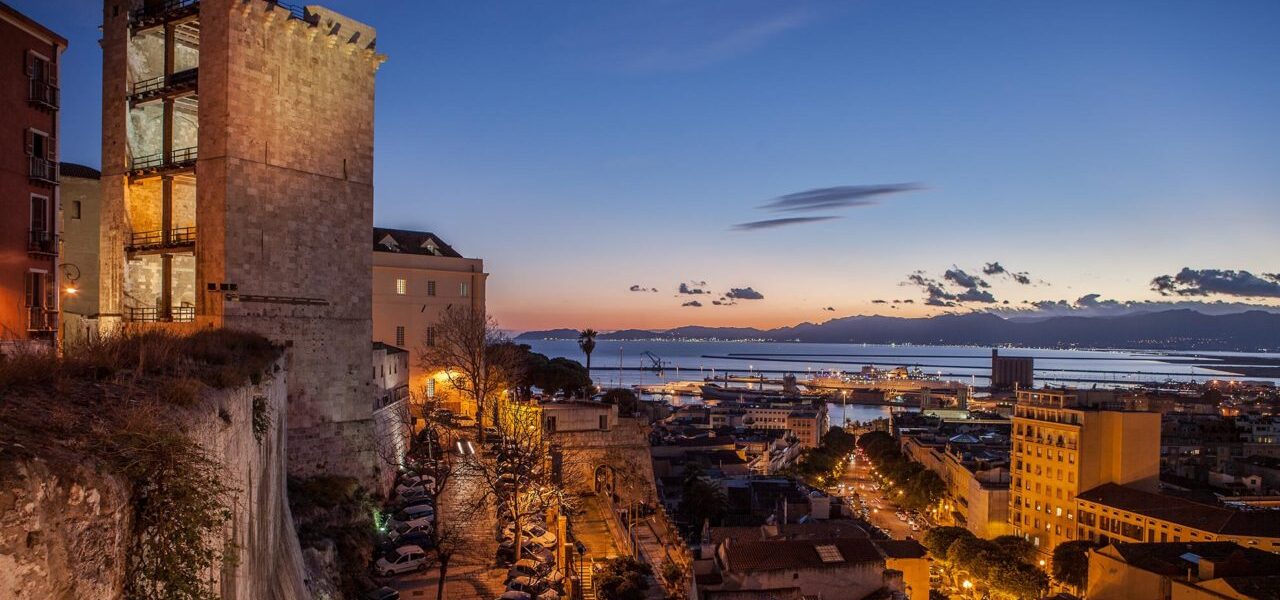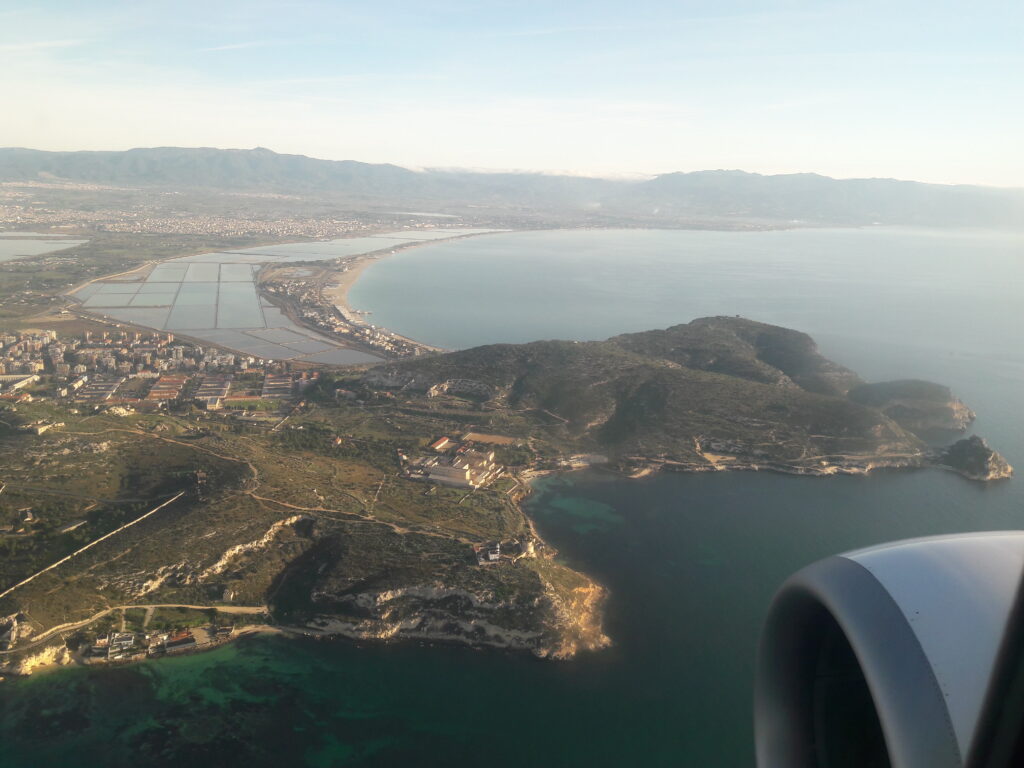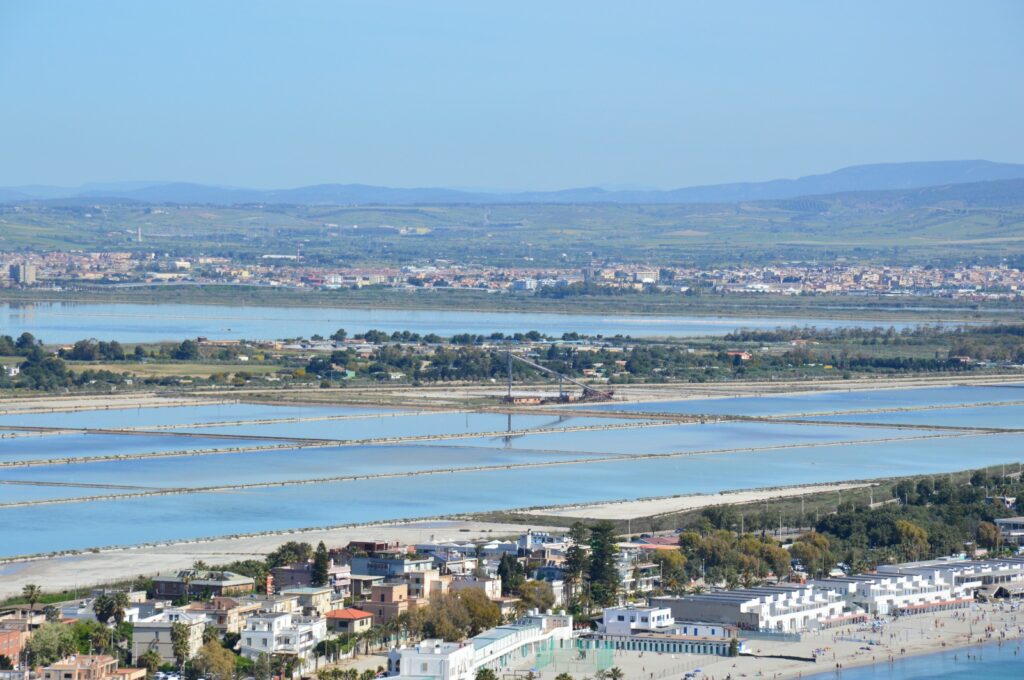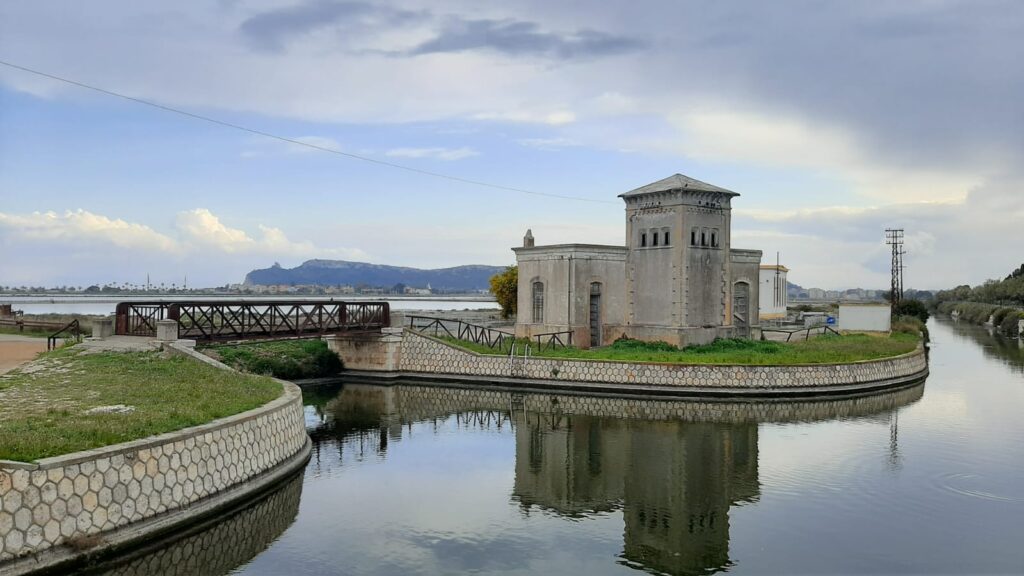
CAGLIARI DA SCOPRIRE
Un intenso profumo di salsedine e di erbe palustri. Il profilo della città contro l’indaco del cielo. Il blu intenso delle acque del Golfo che degrada nel verde acquamarina delle lagune degli stagni salati di Molentargius e Santa Gilla, accese dal maestrale di sfumature rossastre. Poi la luce, intensa, a tratti abbagliante, sempre mutevole, assolutamente unica ed incontrastata protagonista del panorama. Cagliari si presenta così al primo incontro una città “d’ambra e rosetta”, che sembra aprirsi al mondo per accoglierlo, con i moli del suo porto come braccia protese verso l’infinito. Una città nasconde un’anima schiva e solitaria, orgogliosa e remota come la roccia calcarea quasi inaccessibile, per il visitatore distratto, la segreta magia che avvince e lega per sempre chi la abita. Una magia fatta di sole e di tramonti, di stretti vicoli e di squarci di azzurro, di panorami infiniti e di passeggiate in riva al mare, che si alimenta della dolcezza del clima e del ritmo della vita cittadina, lento e rilassato come la cantilenante inflessione della parlata dei suoi abitanti, e che invita a seguire un tempo scandito dalla luce e dalla propria voce interna più che dalle lancette dell’orologio. Venite a conoscerla.
DISCOVER CAGLIARI
An intense perfume of dried salt and marsh grasses. The outline of the city against an indigo sky. The deep blue of the Gulf water that fades into the aquamarine lagoons and salt marshes of Molentargius and Santa Gilla, lit in reddish hues by the mistral wind. The light, intense, sometimes blinding, always changing, the entirely unique and unparalleled protagonist of the view. This is Cagliari at first glance a city of “amber and rose” that seems to open itself to the world and welcome it in, with the jetties of its ports like arms, open towards the infinite stretch ahead. A city that hides a shy and solitary soul, as proud and remote as the limestone rock that seems to cling to it, making the secret magic that conquers and binds those who live there almost inaccessible to the distracted visitor. A magic of sunlight and sunsets, of narrow lanes and strips of blue sky, of infinite views and walks along the shores; a magic that draws energy from the gentle climate and the rhythms of city life, slow and relaxed like the sing-song tones of its inhabitants’ voices; a magic that invites its visitors to follow a passage of time marked by the light and internal sentiments instead of the ticking clock. Come and meet the city.

ARRIVARE A CAGLIARI
Dall’aeroporto alla città.
Appena sette i chilometri che separano l’Aeroporto di Cagliari dal centro della città. Durante i Campionati sarà disponibile un servizio navetta messo a disposizione dall’Organizzazione per gli atleti, i tecnici e i componenti delle Delegazioni. Le informazioni verranno fornite presso l’apposito desk informativo allestito nell’area Ritiro Bagagli della zona Arrivi dell’Aeroporto di Cagliari. In alternativa, è possibile rivolgersi al servizio taxi che, con la tariffa fissa di venti euro, collega l’aeroporto con il centro della città. Una ulteriore più economica alternativa, un trenino delle Ferrovie dello Stato, in cinque minuti e con partenze ogni venti minuti, collega la Stazione di Elmas Aeroporto sino alla Stazione Ferroviaria di Piazza Matteotti al prezzo di €. 1,30. Maggiori informazioni, compresi gli orari dei treni, sono reperibili sul sito della società di gestione dell’Aeroporto SOGAER o sul sito di Trenitalia.
HOW TO GET TO CAGLIARI
From the airport to the city
Just seven kilometres separate Cagliari Airport from the city centre. During the Championships, a shuttle service will be made available by the Organization for athletes, technicians and Delegation members. Information will be provided at a dedicated information desk, which can be found in the Baggage Claim section of the Arrivals area in Cagliari Airport. Alternatively, you can request a taxi, which makes the journey from the airport to the city centre at a fixed rate of twenty euros. Another, cheaper alternative is the train, run by the Ferrovie dello Stato. The journey from Elmas Airport Station to Piazza Matteotti Station takes five minutes, costs €. 1.30, and trains depart every twenty minutes. For more information, including train times, please visit SOGAER, the airport managing company website, or visit the Trenitalia website.
MUOVERSI A CAGLIARI
Cagliari ha un efficiente servizio di trasporto pubblico che, grazie ad una rete di corsie preferenziali, mette al riparo dagli ingorghi stradali. Spostarsi a Cagliari con i mezzi è quindi la scelta più conveniente ed economica.
In autobus
Piazza Matteotti -che si apre davanti alla Stazione Ferroviaria e degli autobus (ed all’ampio parcheggio pubblico), proprio di fronte al Palazzo Civico, e divide a metà la via Roma- è il capolinea delle principali linee degli autobus e dei tram che attraversano la città nelle varie direzioni, compresi quelli che portano al mare e vicino al sito dei Campionati (tutte le linee P, la linea 5ZE e la linea 6), che sono gestite dal CTM. Nella Piazza si trovano l’info Point e lo sportello per la vendita dei biglietti. Il CTM eroga però i propri servizi (vendita di biglietti, informazioni sulle linee e orario in tempo reale) anche tramite una App scaricabile su Apple store o Playstore.
In taxi
Una Stazione di Sosta del Servizio Taxi si trova proprio di fronte alla Stazione Ferroviaria; un’altra è sita di fronte al Palazzo Civico, sul lato del Largo Carlo Felice.
GETTING AROUND CAGLIARI
Cagliari has an efficient public transport service which, thanks to dedicated bus lanes, avoids the daily traffic. Moving around Cagliari by public transport is therefore the least expensive and most convenient choice.
Travelling by bus
Piazza Matteotti is located in front of the railway and coach stations (with ample public parking), just in front of the City Hall (Palazzo Civico), and divides Via Roma into two sections. It is the terminal stop for the main bus and tram lines that run across the city in various directions, including those leading to the seaside and near the Championship site (all P lines, the 5ZE line and line 6). The bus service around the city is managed by CTM. In the square you can find the info point and the ticket sales point. The CTM also provides services (ticket sales, information on bus lines and timetables in real time) via an App, which is available for downloaded from Apple store or Play Store.
…and by taxi
There is a taxi rank located directly in front of the Railway Station and another in front of the City Hall, on the corner of Largo Carlo Felice.

COSA FARE A CAGLIARI
Gli antichi palazzi del quartiere Castello, gli stretti vicoli, animati di voci e di profumi; antiche chiese; vestigia delle dominazioni che, dai fenici ai piemontesi, passando per i cartaginesi, i romani, i pisani e gli aragonesi, hanno reso meticcia la popolazione cagliaritana raccolte in musei siti nei punti più panoramici della città; la spiaggia del Poetto: sette chilometri di spiaggia bianca e un mare cristallino a dieci minuti dal centro della città. E una vita culturale animata da esposizioni temporanee, rassegne di danza e teatro, festival letterari, concerti nelle chiese e nelle arene all’aperto, il Teatro lirico con le sue stagioni sinfoniche e operistiche, una ricca stagione di prosa. Visitate il Portale Turismo del Comune all’indirizzo o l’Infopoint al piano terra del Palazzo Civico per le informazioni sulle iniziative ed attrazioni che costituiscono altrettanti spunti per una visita. Ma per conoscere la città ed imparare ad amarla come i cagliaritani, occorre essere iniziati da qualcuno ai loro riti. Ed è questo che ci proponiamo. Venite con noi …
1. Passeggiare sotto le mura.
Un tempo rifugio per i cagliaritani in fuga dalla pioggia mortale dei bombardamenti del 1942 e 1943, la terrazza dei Giardini Pubblici è oggi il “luogo” delle domeniche in città. Raggiungibile in 5 minuti, dal pieno centro della città, si trova alla fine del Terrapieno, un largo bastione pedonale che offre un altro punto di osservazione sulla città che si stende ai suoi piedi, con il suo dedalo di strade e tetti. In fondo, sospesi tra le lagune, il cielo e il mare, Monte Urpinu e la Sella del Diavolo delimitano l’orizzonte, altrimenti infinito. I Giardini Pubblici sono la casa della Galleria d’Arte Contemporanea, che fa parte del plesso museale che comprende, tra gli altri, il Ghetto degli Ebrei, il Palazzo di Città e l’Exmà, sede di esposizioni temporanee (per info www.museicivicicagliari.it) e ospita i tesori della Collezione Ingrao, tra cui la struggente “Madre dell’Ucciso” dello scultore Ciusa. Anche il vecchio rifugio antiaereo è oggi uno spazio restituito alla città che ospita esposizioni temporanee. Il piazzale antistante, punteggiato di tavoli, sedie e panchine che circondano le due belle fontane, è uno spazio perfetto per leggere i libri in libera consultazione, messi a disposizione dalla Galleria. I Giardini offrono prati verdi e ombre frondose sotto le quali rilassarsi, mentre i bambini giocano ad arrampicarsi sui rami del ficus secolare. Tornando verso la città, sotto le antiche mura, si aprono altri giardini, dove le sculture di Pinuccio Sciola raccontano l’antico nucleo della citta, sommerso nella laguna di Santa Igia e immaginano la Cagliari del futuro.
2. Andare al Mercato di San Benedetto.
Più che un mercato, un tempio del buon vivere…. Fare la spesa per i cagliaritani significa celebrare il rito della convivialità di cui il tripudio di colori e varietà in esposizione sui banchi testimonia il secolare ripetersi…. Perchè a Cagliari mangiare è un imperativo che scandisce le giornate al ritmo invariabile di “colazione-pranzo- aperitivo-cena” Al primo piano, i frutti della Terra sono esposti con la cura e l’attenzione cromatica delle vetrine delle boutique del centro. Mentre al piano sottostante, è il mare, con la sua infinita varietà, che si riversa sui banchi di marmo della piccola pesca, dove lucenti verdoni, dalla livrea che declina le infinite sfumature dell’acqua marina, si mischiano al rosso delle aragoste e dei capponi, alle murene punteggiate di giallo, ai gamberi rosa del Golfo, alle anguille ancora guizzanti, ai polpi, ai calamari, fino al grongo e allo scorfano, i pesci più poveri, ma che nella la zuppa di pesce di Cagliari, sono i protagonisti immancabili…..tra il vociare dei rivenditori che decantano la freschezza dei loro prodotti e qualche contrattazione. Avvicinatevi e chiedete. Scoprirete che a Cagliari si mangiano gli anemoni di mare (le “orziadas” insemolate e fritte in olio croccante) e la salicornia, l’asparago di mare saltato in padella con olio, aglio e peperoncino. I pescatori sono prodighi di consigli e ricette …. e magari pronti a farvi assaggiare una cozza appena sgusciata, da mangiare cruda con uno spruzzo di limone….Come fanno i cagliaritani.
3. Pausa Pranzo al Poetto.
Il Poetto , la “Città Estiva”, è affollato d’inverno come d’estate….. e all’ora di pranzo, i chioschi sparsi sul litorale sono affollati di cagliaritani in pausa pranzo…. Anche perchè al Poetto si può, correre, camminare o andare in bicicletta lungo le piste -una ciclabile, l’altra destinata ai runner- che dal Porticciolo di Marina Piccola arriva fino all’Ospedale Marino e tornare al lavoro dopo aver approfittato di questa palestra en plein air… Oppure consumare un panino, un’insalata o un buon piatto di spaghetti con le arselle seguiti da un caffè su una sdraio sulla sabbia. Perchè a Cagliari il sole scalda anche nelle fredde giornate di gennaio, le più terse dell’anno. E quando le giornate si arroventano, all’ora di pranzo una brezza gentile rinfresca le terrazze di legno. E poi si può sempre fare il bagno, in un’acqua pulita e trasparente a dieci minuti dalla città.
4. Aperitivo al tramonto.
Cagliari è una città di tramonti infuocati. Il sole, come una palla arroventata, si tuffa nello Stagno di Santa Gilla incendiando i palazzi della via Roma e colorando di rosa il calcare della Rocca. Il bastione di Santa Croce è un teatro naturale per questo quotidiano spettacolo. Perchè nelle giornate terse, l’intero golfo si offre alla vista. Sulla terrazza, punteggiata dalle palme, i tavolini di bar e ristoranti o le molte panchine offrono un comodo punto di osservazione. Mentre, poco più avanti la terrazza del Ghetto degli ebrei coniuga la bellezza della natura con i tesori dell’arte delle esposizioni temporanee o dei reading di poesia.
THINGS TO DO IN CAGLIARI
Discover the ancient buildings of Castello, in narrow lanes filled with exciting sounds and smells. Visit timeless churches and follow the footprints of those who conquered the city, from the Phoenicians to the Piedmonts, the Carthaginians, the Romans, the Pisans and the Aragonese, who integrated with the population of Cagliari. Their legacies are preserved in museums that enjoy some of the best views over the city. Stroll down seven kilometres of white sand and crystal-clear waters on Poetto beach, just ten minutes from the city centre. The city’s cultural side is brought to life by temporary exhibitions, dance and theatre shows, literature festivals, and concerts in churches and outdoor arenas. The Teatro Lirico opera theatre offers a rich variety of prose during its symphony and opera seasons. Visit the City Council’s official website, or pop into the Infopoint on the ground floor of the city hall for more information and ideas of attractions and activities to kick-start your visit. But to really get to know this city and learn to love it just as its inhabitants do, you must begin with one or two of their habits. This is exactly what we propose. Come with us…….
1. Take a walk along the walls
Once a place of refuge for the people of Cagliari as they escaped the deadly showers of bombs raining down over Cagliari in 1942 and 1943, the terrace in the Giardini Pubblici is now the place to be on a Sunday. It is located just a five-minute walk from the city centre, at the end of Terrapieno, a large pedestrian bastion that offers yet another stunning view of Cagliari’s labyrinth of streets and roofs, which are sprawled out at its feet. In the background, suspended between lagoons, the sky meets the sea. Monte Urpinu and the Sella del Diavolo line the infinite horizon. The Giardini Pubblici also house the Galleria d’Arte Contemporanea contemporary art museum. Other museums in the City include the Ghetto degli Ebrei, the Palazzo di Città and Exmà, which houses temporary exhibitions such as the treasured “Ingrao Collection”, including the poignant “Madre dell’Ucciso” by the sculptor Ciusa. For more information on museums and exhibitions, please visit www.museicivicicagliari.it. Even the former anti-aircraft shelter has now been returned to the city and hosts temporary exhibitions. The square in front is dotted with tables, chairs and benches around two beautiful fountains. It is the perfect place to read and consult the books made freely available by the Gallery. The Gardens offer green lawns and the shade of leafy trees to relax under, while children climb on the branches of the ancient fig tree. Returning to the city, beneath the ancient walls lie other gardens, where sculptures by Pinuccio Sciola tell the tale of the ancient city, submerged in the Santa Igia lagoon, and imagine the Cagliari of the future.
2. Visit the San Benedetto Market
More than a market, it represents a time of good living…. For the locals, food shopping is a celebration of community life, where the dazzling array of colours laid out on the stalls witness history repeat itself…. In Cagliari, eating is an essential part of the day and dictates the invariable routine of “breakfast-lunch-aperitif-dinner”. Products from the land can be found on the first floor, organized with the same care and attention found in the boutique shop windows of the city centre. The ground floor, on the other hand, is filled with an infinite variety of seafood. Its marble counters are laden with the smallest fish, bright greenbacks whose scales denote the infinite shades of the sea, mixed with the deep reds of lobsters and capons, morays dotted with yellow, pink prawns from the Gulf, fresh eels still darting around, octopus and squid, and finally conger eels and scorpionfish. These last fish are known as the poorer varieties, but become the inevitable protagonists of the local fish soup, the fishmongers guarantee the freshness of their produce and one or two clients begin to bargain. Just approach them and ask. You’ll discover that in Cagliari, we eat sea anemones, breaded and fried in crisp oil and known as “orziadas”, as well as salicornia, known as “sea asparagus” and sautéed with oil, garlic and chilli. The fishmongers are brimming with tips and recipes …. and maybe even offer you a freshly shelled mussel, to eat raw with a squirt of lemon…. just as the locals do.
3. A Lunch Break at Poetto
Poetto, the “Summer Town”, is just as busy in winter as it is in summer….. At lunch time, the kiosks dotted along the coastline are filled with locals on their lunch breaks…. Poetto is also a great place to go for a run, a walk or a bike ride along the promenade: there is a cycle path and a lane dedicated to runners that runs from the tiny port of Marina Piccola until the Ospedale Marino hospital, so you can go back to work refreshed after taking advantage of this open-air gym… Alternatively, you can have a sandwich, a salad or a plate of spaghetti with clams, followed by a coffee lying back on a sun lounger, or even on the sand. In Cagliari, the sun warms even the coldest January days, the clearest of the year. And when the days start to heat up, a gentle lunchtime breeze refreshes the wooden terraces. Then, you can always go for a dip in the clean, transparent water just ten minutes from the city.
4. A Sunset Aperitif
Cagliari is a city of blazing sunsets. The red-hot ball of the Sun plunges into the Stagno di Santa Gilla, scorching the buildings along Via Roma and giving pink hues to the limestone of the Rocca. The Santa Croce bastion is nature’s theatre for this daily spectacle, because on clear days, the entire gulf offers itself to the eye. On the terrace, dotted with palm trees, the tables at the bars and restaurants or the many benches offer a comfortable vantage point. A little further on, the terrace of the Jewish Ghetto combines the beauty of nature with artistic treasures in temporary exhibitions and poetry readings.


